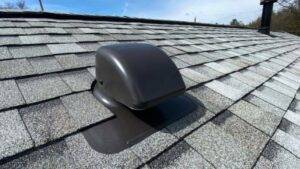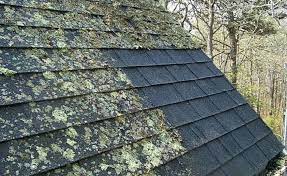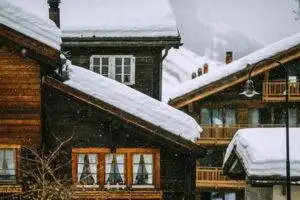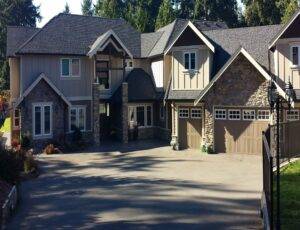Are you planning to replace your roof or build a new home? If so, the color of your roof can have a significant impact on your home’s value and energy efficiency. A well-chosen roof color not only complements the home’s exterior, but also increases its resale value and lowers energy costs. In this blog post, we will explore the various factors to consider when selecting the perfect roof color that suits your house’s architectural style, regional preferences, and the type of roofing material you plan to use. Get ready to boost your home’s curb appeal and make a lasting impression on potential buyers by learning what color roof increases home value!
Short Summary
- Choosing the right roof color can increase a property’s value by taking into account regional preferences and classic, neutral colors.
- Metal roofs and asphalt shingles offer different benefits in terms of cost, durability, energy efficiency when it comes to home value.
- When selecting a roof color for your home consider both personal preference and potential impact on marketability of the property.
Choosing the Right Roof Color for Home Value
Selecting the right roof color is crucial as it can represent up to 40% of your home’s exterior appearance. A coordinated roof and exterior color can augment a property’s value as 91% of home buyers indicated that it is important for them. Real estate professionals agreed, with 94% of them agreeing that a color-coded home exterior elevated the perceived value.
So, how do you go about choosing the best roof color for your home? First and foremost, consider your house’s architectural style. Popular color combinations for the exterior of a home include black and white, tan and white, gray and white. Crimson brick with white trim, white brick with black trim, cream-colored brick with white trim, and cream-colored brick with black trim are also popular choices. It’s essential to harmonize the roof color with your home’s exterior and take into account regional preferences and classic, neutral colors.
Classic and Neutral Colors
When it comes to increasing your home’s resale value, classic and neutral roof colors such as black, gray, brown, and dark blue are your safest bets. These colors are popular choices because they complement most home exteriors and are visually appealing to a wide range of buyers.
By opting for classic, neutral colors, you can ensure that your roof color will not only enhance the overall aesthetic of your home, but also potentially attract more buyers when it’s time to sell.
Regional Preferences
Another important aspect to consider when choosing a roof color is regional preferences and local trends. Geographical position can influence what colors people opt for on a house or roof. Deviating from the local trends with the color of your roof can make your property less attractive to purchasers.
Moreover, the local weather and climate can have an impact on the selection of roof color, suggesting lighter roofs for sunny and hot areas that will not absorb as much heat, thus avoiding an increase in the temperature of the home.
Metal Roofs vs. Asphalt Shingles
Apart from the color, the type of roofing material you choose can also affect your home’s value. Metal roofs and asphalt shingles are two of the most popular roofing materials, each with its own set of advantages and disadvantages. Metal roofs are fire-resistant, recyclable, energy-efficient, and have a long lifespan of up to 50+ years. On the other hand, asphalt shingles are a traditional roofing material that is typically less expensive than metal roofs but has a shorter lifespan of 20-30 years.
When it comes to the impact on home value, metal roofs contribute a lower proportion of their value to an appraisal than laminate shingles. However, the choice between metal roofs and asphalt shingles should be based on your personal preferences, budget, and the specific requirements of your home. Both options offer different benefits in terms of cost, durability, and energy efficiency.
Metal Roof Advantages
Metal roofs have several advantages that make them an appealing choice for homeowners. Their energy efficiency is one of their most significant benefits, as they reflect the sun’s rays and maintain a cooler temperature inside the home during the summer months. Furthermore, their durability is unparalleled, as they can remain in optimal condition for up to 50 years or more with appropriate upkeep. With metal roofing, homeowners can enjoy these long-lasting benefits and energy efficiency.
While metal roofs may be more expensive initially, they can be a smart long-term investment due to their energy efficiency and longevity.
Asphalt Shingle Benefits
Asphalt shingles offer a more affordable option for homeowners seeking a cost-effective roofing solution. They are:
- Durable and straightforward to install
- Provide protection from the elements, including fire and wind resistance
- Come in a range of colors and styles to suit various aesthetic preferences.
While they may not last as long as metal roofs, asphalt shingles can still provide an attractive and reliable roofing option for many homeowners.
Energy Efficiency and Roof Color
The color of your roof can play a significant role in your home’s energy efficiency and overall value. A well-coordinated roof and exterior color can not only enhance the aesthetic appeal of your home, but also influence heating and cooling costs. In fact, some products like the Cambridge Cool colors Collection Shingles are designed to reduce a home’s heating and cooling costs, potentially saving homeowners money without reducing the asking price.
Some buyers may be drawn to energy efficiency and environmental considerations when searching for a new home. Therefore, choosing a roof color that reflects sunlight and heat can help increase the energy efficiency of your home, ultimately making it more attractive to potential buyers.
Light vs. Dark Roofs
Light and dark roofs differ in terms of heat absorption and reflection. Light roofs demonstrate a higher degree of heat reflection than dark roofs, whereas dark roofs demonstrate a higher degree of heat absorption.
When selecting between light and dark roof colors, it’s essential to consider factors such as:
- Direct sunlight
- Tree coverage
- Attic ventilation
- Overall aesthetic
Choosing a lighter roof color can diminish the amount of heat the roof retains, making your home more energy efficient.
Cool Roofs
Cool roofs are designed to:
- Reflect more sunlight than traditional roofs
- Decrease the temperature of the building
- Result in lower energy bills
- Improve human health and comfort by reducing air temperatures inside buildings.
When selecting a cool roof, consider the following factors:
- Climate
- Building’s design
- Roof’s slope
- Roof’s color
Lighter colors are known to reflect more sunlight than darker colors.
Coordinating Roof Color with Home’s Exterior
Choosing a roof color that harmonizes with your home’s exterior is vital to boost curb appeal and attract potential buyers. A new roof can have a considerable effect on the overall curb appeal of a home, and buyers form quicker emotional connections with homes that impress them from the driveway.
In order to make an informed decision on the right roof color, it’s essential to consider factors such as matching siding and roof colors and taking into account the house’s architectural style.
Matching Siding and Roof Colors
When selecting roof colors that complement your home’s siding color, it’s essential to contemplate complementary hues. As a general principle, pair a warm color with another warm color, and a cool color with another cool color. Personal preference and the style of the house should also be taken into account when deciding on roof colors that harmonize with the home’s siding color.
When considering the overall look of the house, it’s important to take into account the home’s exterior appearance, including the color of the siding and the roofing.
Considering Architectural Style
Taking the home’s architectural style into account when selecting a roof color is crucial for ensuring the color is aesthetically compatible with the home. Specific colors may be more suitable for certain styles of homes. For instance, a classic Colonial style home may be complemented by a black or dark gray roof, while a Craftsman style home may be aesthetically enhanced by a lighter gray or brown roof.
By considering your house’s architectural style, you can make a more informed decision on the perfect roof color.
Roof Replacement and Home Value
A new roof can potentially augment the value of your residence should you choose to put it on the market. However, the return on investment for a roof replacement, especially when replacing an old roof, is estimated to be approximately 60%, although this number can vary significantly depending on your geographical area and individual circumstances.
When investing in a roof replacement, it’s important to consider factors such as the quality of roofing materials, the state of the roof, and real estate market factors.
Return on Investment
The return on investment for roof replacement is generally superior to that of other home renovations, such as painting, landscaping, and updating appliances. Factors such as the location, quality of the materials employed, and the present condition of the roof can all affect the return on investment for a roof replacement.
For instance, if the roof is in a state of disrepair, the return on investment may be greater than if the roof is in a satisfactory condition.
Quality Roofing Materials
To maximize the value of your home, it’s essential to utilize high-quality roofing materials that can safeguard your home from the elements, diminish energy costs, and augment the lifespan of the roof. Slate is the optimal choice for augmenting the value of a home, as it is the most resilient and has the longest lifespan of any roofing material.
Other viable options include clay, which boasts a lifespan of approximately 100 years, and asphalt shingles, which are more economical but not as resilient as other materials.
Neighborhood Considerations
When choosing a roof color, it’s essential to consider the surrounding neighborhood and any local rules or recommendations. Ensuring that your roof color blends in with the neighborhood can prevent your home from appearing conspicuously different from other residences and make it more attractive to potential buyers.
To coexist harmoniously with your neighbors, it’s important to take into account factors such as fitting in with the neighbors and adhering to local rules and recommendations.
Fitting In with Neighbors
Selecting a roof color that matches nearby homes and buildings can have a positive impact on your home’s value and desirability to potential buyers. By fitting in with your neighbors, you can foster a positive environment in the neighborhood and potentially increase your home’s value.
When selecting a roof color, it’s essential to consider the colors of the surrounding homes as well as any local rules or recommendations.
Local Rules and Recommendations
Local regulations and recommendations concerning roof color can vary depending on the locality and climate. Most contractors agree that roofing and siding should contrast in hue, with light-colored siding being the best option for a home with a dark-colored roof, and vice versa. Utilizing a darker roof with lighter siding is a popular choice and is naturally attractive.
It is also advisable to consult with your local municipality for any ordinances that may restrict roof appearance or color.
Consultation with Professionals
Choosing the right roof color can be a daunting task, which is why consulting with professionals can provide invaluable guidance and ensure an informed decision. Professional roofers can offer expert advice on the optimal color choices based on your home’s architecture, neighborhood trends, and shingle colors in various lighting conditions.
They can also provide complimentary roofing estimates and assign a project manager to support homeowners throughout the entirety of the roof replacement process.
Expert Advice
Obtaining professional advice when selecting a roof color can assist homeowners in making an educated decision. Expert guidance can help you consider factors such as the home’s architecture, neighborhood trends, and shingle colors in various lighting conditions to guarantee the color coordinates with your home.
By seeking professional guidance, you can ensure that your roof color not only enhances the overall aesthetic of your home, but also potentially attracts more buyers when it’s time to sell.
Personal Preferences
At the end of the day, your personal preferences play a crucial role in choosing the perfect roof color for your home. While it’s essential to consider factors such as the home’s architecture, neighborhood trends, and local rules or recommendations, it’s important to select a roof color that you enjoy and feel proud of.
Ultimately, the decision should be based on a balance between your personal preferences and the potential impact on your home’s value and marketability.
Summary
In conclusion, selecting the right roof color has a significant impact on your home’s value, energy efficiency, and curb appeal. By considering factors such as your house’s architectural style, regional preferences, and the type of roofing material, you can make an informed decision that will not only enhance the aesthetic of your home but also attract potential buyers. Don’t forget to consult with professionals and take into account your personal preferences when making this important decision. A well-chosen roof color can ultimately boost your home’s value and make it stand out in the real estate market.
Frequently Asked Questions
What color roof has the best resale value?
For the best resale value, it’s recommended to choose a roof color that is neutral, such as tan, brown, black, or gray.
Should the roof be darker or lighter than the house?
It is recommended to have darker roofing than siding for aesthetic purposes, with light-colored siding on a home that has a dark-colored roof.
What factors should I consider when choosing a roof color for my home?
When choosing a roof color for your home, consider the style of your house, regional trends, local preferences and roofing material in order to make an informed decision that will maximize its value and appeal.
Take into account the color of the siding, the color of the trim, and the color of the shutters. Look at the colors of the neighboring homes and the colors of the homes in the area. Consider the climate and the amount of sunlight the roof will receive. Research the topic.
How does a roof color affect a home’s energy efficiency?
A lighter colored roof can help reflect the sun’s rays and reduce the amount of heat transfer into the home, resulting in increased energy efficiency.
This can help to reduce energy costs and make the home more comfortable.
What is the difference between metal roofs and asphalt shingles?
Metal roofs offer greater longevity and fire-resistance than asphalt shingles, which are more traditional and cost-effective but have a shorter lifespan.
This makes metal roofs a great choice for those looking for a long-term roofing solution. They are also more resistant to extreme weather conditions, such as hail and high winds. Additionally, metal roofs are more energy efficient than asphalt.






